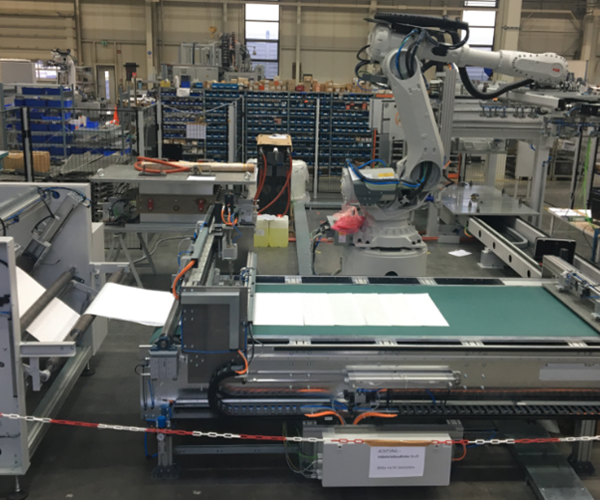An SMC machinery provider adds automation
About the time that I started writing about the composites industry, I was introduced to the concept of SMC – sheet molding compound. I was intrigued this year at the JEC World in Paris to meet with a German company, Schmidt & Heinzmann (S&H, Bruchsal, Germany).

A Schmidt & Heinzmann automated SMC cutting/preforming cell
About the time that I started writing about the composites industry, I was introduced to the concept of SMC – sheet molding compound. SMC was already a well-established technology then, and that was about 20 years ago. The concept of cutting the glass roving over the moving resin film, flattened by the doctor bar, was explained to me by the principals of Finn & Fram (San Fernando, CA, US), including Dr. Jerry Fram. Many articles about SMC and its growth trajectory, including ever-improving quality and lower density, as well as machine improvements, have followed in CW ever since. So, I was intrigued this year at the JEC World in Paris to meet with a German company, Schmidt & Heinzmann (S&H, Bruchsal, Germany), a name that has turned up almost every time I tour a composites facility and see its equipment. It got its start in 1949 producing machinery for the plastics industry and started selling SMC and BMC equipment in 1973. It considers itself the leader in SMC technology, and is currently producing a wide variety of automated solutions for composites processing that go beyond just sheet molding compound production.
One is an automated bonding cell for composite parts. Developed in response to the need to increase part cycle times for large-volume production, S&H built the cell for Euro Advanced Carbon Fiber Composites GmbH (EACC, Esslingen am Neckar). EACC is a subsidiary of Toray Industries Inc. and is focused on the processing, manufacturing and sales of carbon fiber reinforced plastics (CFRP) and glass reinforced plastics (GFRP) for the premium automotive sector in Europe. One part EACC produces is trunk lids in glass SMC with Class A finish, and it wanted a way to bond, economically and quickly, the inner and outer shells of the parts in a pressing process, that includes attaching additional metal and composite inserts including the hinge reinforcement, lock plates, light pods and more. According to S&H, “The components do not just have to be pressed and bonded very precisely; a high level of process stability is also required for automobile production.”
The trunk lid components have complex geometry and are made up of multiple parts. Testing included determining factors such as the chemical reactivity speed and the surface tension of the composite; the cell also had to be able to accept various adhesives to meet any process changes. Dr. Stephan Roßner, EACC vice president for development, production and quality, says “With our new machine, we are pursuing a cycle time of less than 15 minutes for all of our five trunk lid versions produced, while maintaining an assembly precision in the tenths of a millimeter range.” He adds that in designing the process, they could find no comparable machine from other vendors.
The bonding cell includes multiple S&H articulated robotic arms and two adhesive mixing heads to handle different adhesives. S&H says the challenges in creating the work cell included the simultaneous assembly of multiple components within the optimal cycle time and balancing the cycle time with the adhesive cure time, while bonding the multiple components in parallel. The robotic arms, says S&H, allows more freedom of movement for access to the adhesive surfaces of the complex part, and can carry out positional checks to ensure correct part placement. The heated pressing tool, which consolidates the bonded assembly, helps accelerate the adhesive cure to meet the cycle time. Flexibility is built into the bonding cell, which can be easily reconfigured based on any changes in CAD data for different part geometries. Here’s the youTube video showing the bonding cell in action:
And that’s just one of the innovative designs at JEC World. Another is an automated SMC blank cutting and press loading process for a proprietary client, whose cycle time demanded automated loading of SMC blanks into the mold, and better repeatability in SMC blank positioning. The “smart” work cell takes SMC rolls, removes the film, then cuts the material for a 6-axis pick-and-place robot, which transfers the cut material, consisting of large and small cut pieces that form a complete blank, to a scale for weighing. The weights are fed back to the cutter, which can make small changes in cuts on subsequent pieces to keep the total weight of the part blank within 3% of the target value. A second feed robot transfers the blank to the mold. S&H says the tilting and pressing functions integrated in the feed robot’s gripper ensure correct positioning even for complicated blank shapes. A big challenge in this project was the cutting, says the company. Cutting SMC is tricky, since glass fibers can be pulled out of the mat, or broken off, during the cut, and fiber/resin residue on the cutting head can introduce defects. S&H developed its AutoCut 2D cutting system to address these issues for mat semi-finished materials. The customer relates that the process is stable and has contributed to a low defect rate and very little unit downtime, and the investment has been amortized “very quickly.”
Keep an eye on more composites automation solutions for automotive parts from Schmidt & Heinzmann. The company will be exhibiting at the upcoming Society of Plastics Engineers’ Automotive Composites Conference and Exhibition (SPE ACCE) in Novi, MI, US September 5-7, 2018.
Related Content
Pittsburgh engineers receive $259K DARPA award for mussel-inspired underwater adhesion
The proposed META GLUE takes inspiration from hydrogels, liquid crystal elastomers and mussels’ natural bioadhesives to develop highly architected synthetic systems.
Read MoreBiDebA project supports bio-based adhesives development for composites
Five European project partners are to engineer novel bio-based adhesives, derived from renewable resources, to facilitate composites debonding, circularity in transportation markets.
Read MoreHenkel releases digital tool for end-to-end product transparency
Quick and comprehensive carbon footprint reporting for about 58,000 of Henkel’s adhesives, sealants and functional coatings has been certified by TÜV Rheinland.
Read MorePerformance resins, putties and structural adhesives
CAMX 2025: Scott Bader illustrates its local and global materials supply availability backed by technical support, as well as a novel composite panels development with Armacell.
Read MoreRead Next
Cutting 100 pounds, certification time for the X-59 nose cone
Swift Engineering used HyperX software to remove 100 pounds from 38-foot graphite/epoxy cored nose cone for X-59 supersonic aircraft.
Read MoreCeramic matrix composites: Faster, cheaper, higher temperature
New players proliferate, increasing CMC materials and manufacturing capacity, novel processes and automation to meet demand for higher part volumes and performance.
Read MoreNext-gen fan blades: Hybrid twin RTM, printed sensors, laser shock disassembly
MORPHO project demonstrates blade with 20% faster RTM cure cycle, uses AI-based monitoring for improved maintenance/life cycle management and proves laser shock disassembly for recycling.
Read More












